Things were hotting up at Thames Road Wetland on Tuesday (June 16th). Reed Bunting bred on site in 2013, but last year the male seemed to spend most of the summer singing, with no apparent success. Now he is back (well, he’s using almost exactly the same place to sing from, so maybe it’s the same bird) and calling again. Let’s hope a passing female can hear him above the drone of the passing traffic, and will be suitably impressed.
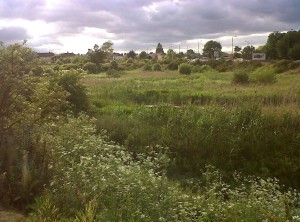
Thames Road Wetland looking west. Allowing a modest amount of Willow scrub to develop has attracted Reed Bunting and Sedge Warbler. (Photo: Chris Rose)
There was a Cetti’s Warbler calling from within the bowl of the site, as well as another nearby on Stanham Farm, and a third – probably different – individual had been heard by the Cray halfway along By-way 105.
Marsh Frogs called briefly from one of the ditches.
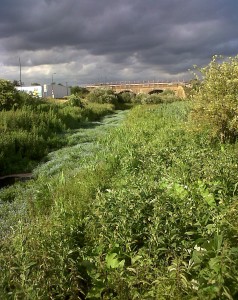
The River Wansunt at Thames Road Wetland under a brooding sky, but on a very hot day. (Photo: Chris Rose)
Odonata activity was limited due to the heat, but Azure and Blue-tailed damselflies were on the wing, and a male Banded Demoiselle, a species of running water, was flapping about, perhaps having wandered off the Cray or River Wansunt. A flash of amber-coloured wings as I disturbed vegetation by the Wansunt can only have been a Brown Hawker, but I couldn’t see where it went.
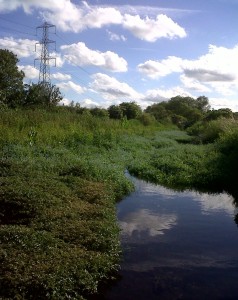
The channel of the Wansunt at Thames Road Wetland is occupied by an excellent display of Water Forget-me-not at this time of year. (Photo: Chris Rose)
It was pleasing to see one Small Tortoiseshell butterfly on the site, and two spiralling after each other adjacent to it, along with a solitary Red Admiral.
It’s worth checking any White Bryony in the Borough these days for the presence of the Bryony Ladybird, a natural immigrant first found in the UK in 1997, especially where the leaves are rather yellow mottled. Sure enough three larvae were located on leaf undersides up on the Sewer Pipe Embankment. There may have been more. I have found it at several locations along the lower Cray, and on my allotment site in Barnehurst.
The very rare London plant Brookweed (Samolus valerandi) was putting on a fabulous show at what may be its only site in London, other than nearby Crayford Marshes, though it must be admitted that the small flowers of this Primula relative need to be seen up close for full appreciation. It’s certainly the best publicly accessible display in the capital. There was about 18 square feet of almost solid Brookweed in flower and signs it is spreading by itself, and with the help of some seed broadcasting by me. Trampling of the ground and grazing by ponies at this end of the site are key to the success of this plant here.
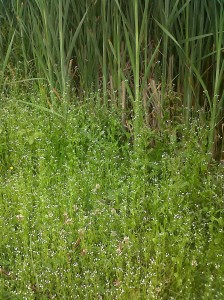
A swathe of Brookweed, along with Rushes, occupy the draw-down zone at the east end of the site, where falling water levels in summer leave permanently wet mud. This plant’s success here is dependent on winter pony grazing and trampling. (Photo: Chris Rose)
Two of the 9 Marsh Sow-thistles planted last year on the pony-accessible east bank of the Wansunt, all thought to have been lost to grazing, are regrowing. We shall see how they fare.
An adult Common Lizard was found late on, sitting on top of a pile of cut reed, in a spot apparently cut off from any suitable Lizard habitat by a dense swathe of Reed Canary Grass. However, our friends at Rainham have said Lizards have spread around their site using the reedbed boardwalks …..
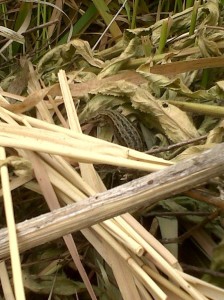
Common Lizards are not averse to showing up in unexpected, damper parts of the site. (Photo: Chris Rose).
Efforts to re-open the path along one of the ditch bunds to access existing Marsh Sow-thistles, plant new ones further along and look for more Harvest Mouse nests were thwarted by the fact that an active Reed Warbler nest was spotted in the reeds that have ‘invaded’ the route. In order to access the western half of the bund, I shall now have to wade across from the other end of the site in wellies on some future visit.
Chris Rose. Thames21 Thames Road Wetland Volunteer Site Manager.
